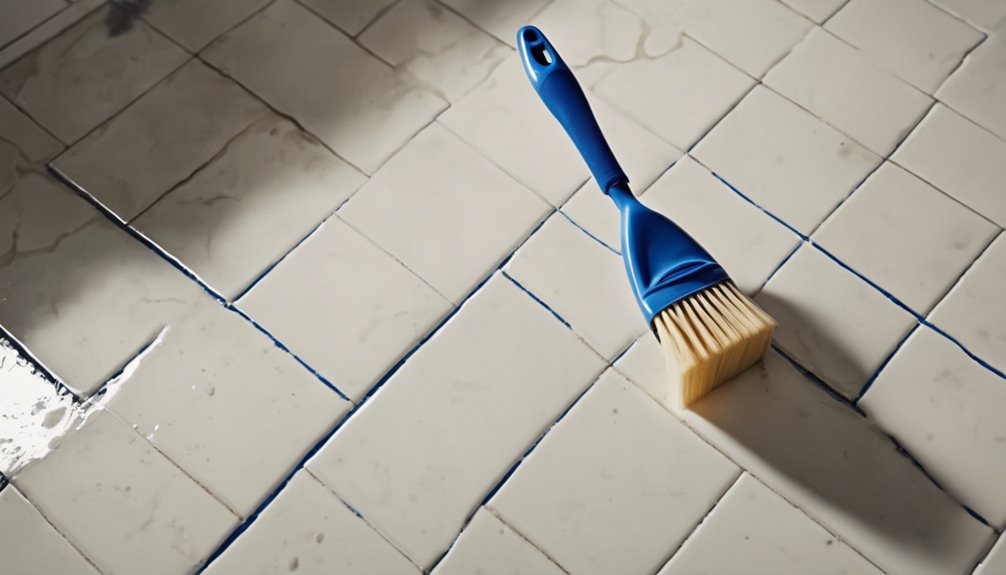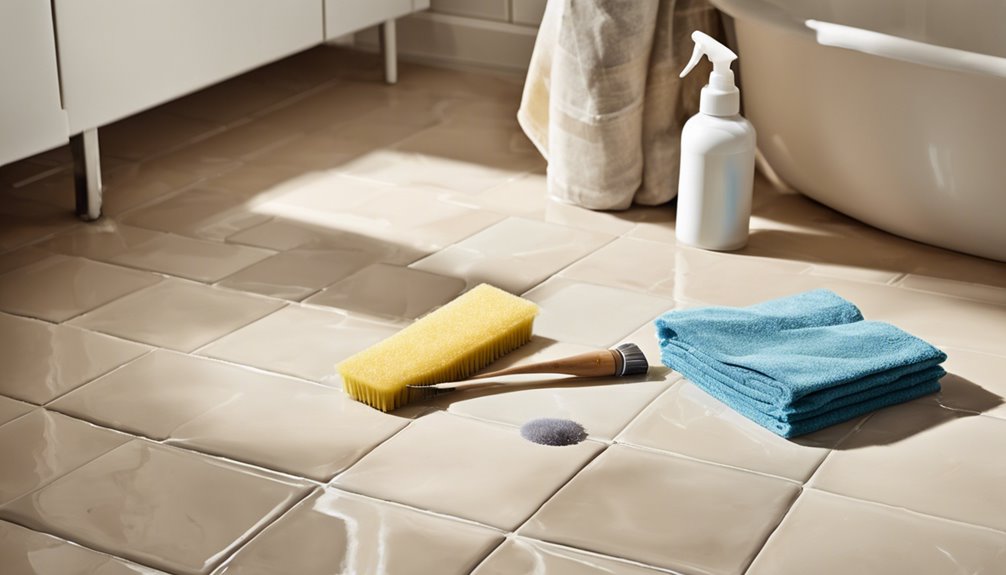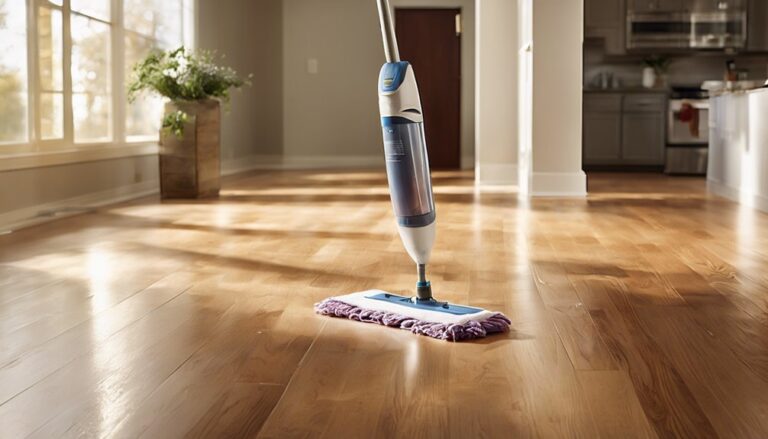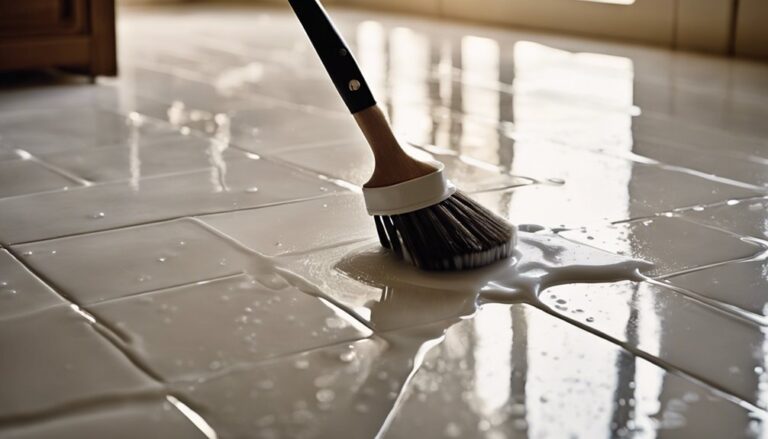To clean tile grout on floors, start by gathering essential supplies like a grout brush, spray bottle, and either a commercial cleaning solution or a natural remedy mix, such as baking soda and vinegar. Apply your chosen cleaning solution directly onto the grout lines and let it sit for a few minutes. Scrub the grout with the brush in a circular motion, then wipe away the residue with a microfiber cloth. For ongoing maintenance, establish a cleaning routine and consider sealing your grout every few years to prevent stains. More effective techniques will be explored to enhance your grout cleaning skills.
Understanding Tile Grout

Tile grout, often overlooked, plays an essential role in the aesthetics and integrity of tiled surfaces. Understanding the various grout types and grout colors is vital for achieving the desired look and functionality in your space. There are generally two main types of grout: sanded and unsanded. Sanded grout, ideal for wider joints, provides strength and prevents cracking, while unsanded grout, suitable for narrow joints, offers a smoother finish. Grout colors can greatly impact the overall appearance of your tiles; choosing a color that complements your tiles enhances visual appeal. By selecting the right grout type and color, you not only enhance your tiled surfaces but also guarantee longevity and resilience, allowing you to enjoy a beautiful, functional space for years to come.
Essential Cleaning Supplies
To maintain the beauty and functionality of your tiled surfaces, having the right cleaning supplies on hand is important. Start with high-quality grout brushes; their stiff bristles are designed to effectively scrub away dirt and stains from grout lines without damaging the tile. You'll also need a selection of cleaning solutions tailored for grout. Whether you prefer natural options or commercial products, make certain they're suitable for your tile type. A spray bottle will come in handy for easy application, allowing you to target areas that need extra attention. Additionally, keep a bucket and microfiber cloths nearby for rinsing and drying surfaces. With these essential supplies, you'll be well-equipped to tackle the task and restore your tile's original luster.
Store-Bought Cleaning Solutions

When you're looking to simplify your grout cleaning routine, store-bought cleaning solutions can be a highly effective option. Commercial cleaners specifically designed for grout can save you time and effort. Here's a quick comparison of some popular grout removers you might consider:
| Nom du produit | Taper | Caractéristiques principales |
|---|---|---|
| Grout Cleaner A | Commercial Cleaner | Fast-acting formula |
| Grout Remover B | Gel-based Remover | Penetrates deep stains |
| Grout Cleaner C | Oxygen bleach | Eco-friendly option |
| Grout Remover D | Spray applicator | Easy to use |
| Grout Cleaner E | Acidic cleaner | Heavy-duty strength |
Choosing the right product can help restore the beauty of your tile floors effortlessly, giving you the freedom to enjoy a cleaner home.
Natural Cleaning Remedies
Although many people rely on commercial cleaners, natural cleaning remedies can be just as effective for tackling stubborn grout stains. One popular method involves creating a baking soda and vinegar mixture. Simply combine these two ingredients to form a paste, then apply it to the grout. For a citrusy boost, lemon juice can be added to enhance the cleaning power. Alternatively, hydrogen peroxide works wonders on tough stains; apply it directly to the grout and let it sit for a few minutes before scrubbing. Whichever remedy you choose, remember to test it in an inconspicuous area first. These natural solutions not only clean effectively but also promote a healthier home environment, free from harsh chemicals.
Processus de nettoyage étape par étape

After exploring natural cleaning remedies, it's time to implement a systematic approach to clean your tile grout effectively. Follow these steps to achieve that pristine look:
- Rassemblez vos fournitures: You'll need a grout cleaner, a brush with stiff bristles, and a mop or cloth.
- Apply the Cleaner: Generously apply your chosen grout cleaning solution to the stained areas, letting it sit for a few minutes to penetrate.
- Effective Scrubbing: Use your brush to scrub the grout, focusing on tough stains with various grout cleaning techniques.
- Rincer et sécher: Wipe down with a damp cloth or mop, ensuring no cleaner residue remains.
Preventing Future Grout Stains
To prevent future grout stains, you'll want to establish a regular cleaning schedule tailored to your space's specific needs. Additionally, applying a high-quality sealant can greatly enhance your grout's resistance to stains and moisture. By combining these strategies, you can maintain the cleanliness and longevity of your tile surfaces.
Programme de nettoyage régulier
Regularly maintaining your tile grout is essential for preventing future stains and preserving its appearance. Establishing a consistent cleaning frequency helps keep your grout in top shape. Here's a simple maintenance routine you can follow:
- Nettoyage hebdomadaire: Sweep or vacuum to remove debris and mop with a gentle cleaner.
- Monthly Scrubbing: Use a grout brush and a suitable cleaning solution to tackle any buildup.
- Nettoyage des taches: Address spills immediately to prevent stains from setting in.
- Nettoyage annuel en profondeur: Consider a thorough professional cleaning to refresh your grout and tiles.
Sealant Application Tips
While maintaining a clean and aesthetically pleasing tile grout is essential, applying a sealant can greatly enhance its durability and resistance to stains. First, choose the right sealant types for your grout—water-based or solvent-based, depending on your needs. Next, verify the grout is completely dry and clean before application. Use a high-quality applicator or brush for even coverage, applying the sealant in small sections. Follow the manufacturer's instructions regarding drying time. For best results, consider reapplying every 1-3 years, as this can prevent future stains and keep your grout looking fresh. Finally, always test in an inconspicuous area first to verify compatibility and desired finish. Enjoy the freedom of low-maintenance grout with these effective techniques!
Questions fréquemment posées
How Often Should I Clean My Tile Grout?
You should aim for grout maintenance frequency of every three to six months, depending on your lifestyle. If you've pets or kids, consider cleaning more often. For a successful cleaning schedule, incorporate routine inspections to catch stains early. When you notice grime building up, take action promptly. This proactive approach not only keeps your grout looking fresh but also prolongs its lifespan, giving you the freedom to enjoy a clean, inviting space.
Can I Use Bleach on Colored Grout?
Using bleach on colored grout isn't recommended; it can lead to discoloration over time. In fact, studies show that nearly 70% of homeowners experience fading of colored grout when using harsh chemicals. Instead, consider bleach alternatives like vinegar or baking soda for safe cleaning. For colored grout care, stick to gentle solutions that maintain its vibrancy while effectively removing stains. Regular maintenance can help preserve that fresh, clean look you desire without risking damage.
Is It Safe to Steam Clean Grout?
Yes, it's safe to steam clean grout. In fact, using grout steamers can be a highly effective method. Steam cleaning benefits include deep cleaning without harsh chemicals, helping to eliminate bacteria and mildew. The high temperature of the steam penetrates the grout, loosening dirt and stains. Just be sure to follow the manufacturer's instructions for your steam cleaner to guarantee ideal results and protect your surfaces. Enjoy the freedom of a cleaner, healthier space!
Will Cleaning Grout Damage My Tiles?
When you're tackling the question of whether cleaning grout will damage your tiles, think of the care you'd give to a classic painting. Using proper grout cleaning techniques guarantees tile surface protection. Avoid harsh chemicals or abrasive tools that could scratch or discolor your tiles. Instead, opt for gentle solutions, like vinegar or baking soda. By approaching the task thoughtfully, you can maintain the beauty of your tiles while enjoying a fresh, clean space.
How Can I Tell if Grout Needs Replacing?
To tell if your grout needs replacing, look for grout discoloration causes like dark stains or persistent dirt that won't come out. If you notice cracks, crumbling, or mold growth, these are clear grout repair signs. Also, if water seeps through the grout, it might indicate a failure in its integrity. Regularly inspecting your grout can help you maintain your tiled surfaces and keep them looking fresh and clean.




